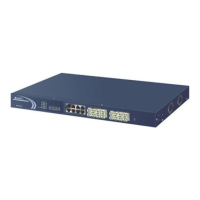
Do you have a question about the Ruby Tech FGS-2824 and is the answer not in the manual?
Provides a detailed overview of the FGS-2824 L2 Managed Switch, its features, and capabilities.
Lists the essential items to verify in the package before starting the switch installation.
Details the hardware and management features of the FGS-2824 L2 Managed Switch.
Describes the physical layout and user interfaces on the front panel of the switch.
Explains the front panel components, including ports, LEDs, and buttons for switch operation.
Details the user interfaces and connectors located on the rear panel of the switch.
Lists and describes the various optional SFP fiber transceiver modules supported by the switch.
Guides users through the initial steps of powering up and configuring the switch.
Provides instructions for physically installing hardware and connecting necessary cables.
Details the process of mounting the switch chassis into a standard 19-inch wiring closet rail.
Outlines the necessary cable specifications and requirements for optimal network performance.
Specifies the required cable grades and lengths for connecting TP ports.
Details the cabling requirements for different types of SFP fiber optic modules.
Explains considerations for cascading switches, including delay time and network topology.
Describes the methods for configuring the switch's management agent via console or Ethernet.
Provides step-by-step instructions for configuring the switch using a serial RS-232 connection.
Explains how to configure the switch's management agent via an Ethernet port connection.
Details the process and parameters for assigning IP addresses, subnet masks, and gateways.
Illustrates common deployment scenarios and applications for the switch.
Introduces the web management interface and the system information displayed upon login.
Describes the system parameters and information available in the System Information section.
Details how to configure IP settings, including DHCP, IP address, subnet mask, and gateway.
Explains how to set the system time manually or via NTP, including daylight saving options.
Describes how to manage user accounts, including creating, modifying, and deleting users.
Outlines rules for controlling user access and connection to the switch for security.
Explains the Virtual Stack Management (VSM) function for grouping multiple switches.
Covers functions related to monitoring and managing switch ports.
Displays current status information for all ports, including link, state, and auto-negotiation.
Allows configuration of each port's operation mode, including state, speed, and duplex.
Shows summary traffic counts for each port, such as bytes and packets transmitted/received.
Provides detailed traffic counts per port, including packet types and error information.
Configures port mirroring to monitor network traffic by copying packets to a specific port.
Sets limits for ingress and egress bandwidth for each port to manage traffic flow.
Configures Quality of Service settings to prioritize network traffic based on various criteria.
Assigns QoS priority (High/Low) to individual ports for traffic management.
Sets priority for traffic based on VLAN tags, allowing 8 traffic classes.
Classifies traffic based on the IP header's TOS field for Layer 3 QoS.
Configures SNMP settings, community names, and trap hosts for network management.
Enables IGMP snooping to efficiently forward multicast packets and manage bandwidth.
Sets the maximum packet length, supporting jumbo frames up to 9216 bytes.
Configures delay for DHCP and boot processes to prevent network congestion.
Supports VLAN configuration, including tag-based and port-based VLANs for network segmentation.
Allows selection of VLAN modes such as Port-based, Tag-based, Metro, and Double-tag.
Manages tag-based VLAN groups, allowing creation, editing, and deletion of groups.
Manages port-based VLAN groups, enabling creation, editing, and deletion of groups.
Configures VLAN tag rules, including PVID and ingress filtering rules for ports.
Manages MAC table information, including learning, maintenance, and aliasing.
Displays static or dynamic MAC entries and their states for selected ports.
Configures MAC table processing, including aging time and flushing entries.
Configures GVRP for dynamic VLAN membership management across switches.
Configures Spanning Tree Protocol (STP) to prevent network loops and ensure single active paths.
Displays current STP status parameters, including bridge ID, priority, and port states.
Sets STP parameters such as bridge priority, hello time, and max age.
Configures STP settings for individual ports, including path cost and priority.
Configures link aggregation (trunking) for ports to increase bandwidth.
Configures 802.1x port-based network access control for user authentication.
Sets up trap events and email/SMS notifications for system alerts.
Configures which trap events trigger notifications via email, SMS, or SNMP traps.
Specifies email addresses and mobile numbers to receive alarm messages.
Manages switch configurations, including default, working, and user-defined settings.
Saves and restores switch configurations to flash memory.
Manages configuration files, allowing backup and reload via TFTP.
Performs system self-diagnostics, including loopback and ping tests.
Runs basic system checks like EEPROM, UART, DRAM, and Flash tests.
Tests internal and external loopback functionality for network port verification.
Verifies network connectivity by checking if target devices are alive using ICMP.
Configures the IP address of the TFTP server for firmware upgrades and file transfers.
Displays system log data, including trap events, and allows log management.
Provides the tool to upgrade the switch's firmware via TFTP.
Allows the switch to be rebooted, either directly or after saving current settings.
Manages user logout, including manual, implicit, and auto-logout functions.
Provides basic information on connecting and accessing the switch via the Command Line Interface (CLI).
Details the process for logging into the switch using the CLI, including default credentials.
Explains how to use CLI commands, categorizing them into global and local commands.
Lists and describes global CLI commands like 'end', 'exit', 'help', and save/restore functions.
Explains local CLI commands that are specific to different modes of operation.
Provides common causes and troubleshooting steps for a 'no link' LED status on switch ports.
Offers answers to frequently asked questions regarding connectivity and configuration issues.